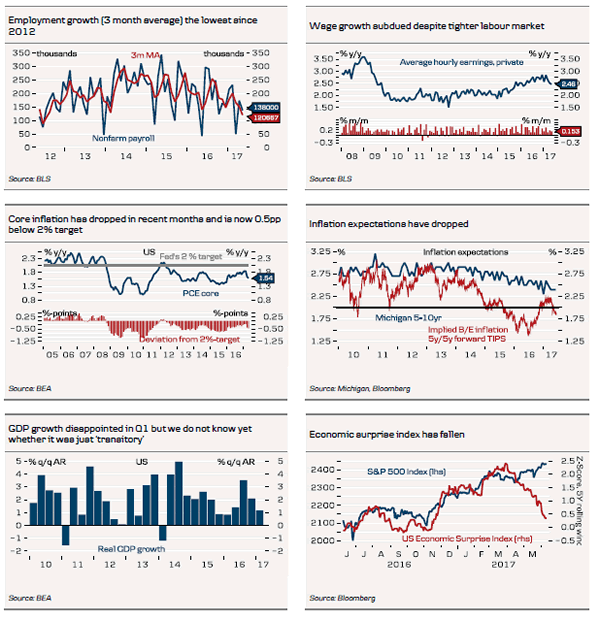- We were obviously wrong about our non-consensus call that the Fed would skip hiking at this meeting. However, we are surprised that the Fed is not more worried about low inflation. We still fear the Fed is making a policy mistake, as economic data do not justify a hike, in our view.
- Unchanged dots but four FOMC members expect no further hikes this year – and we guess three of them are voting members. This puts a third hike this year into question.
- Fed may hike again in December, as it targets unemployment but risks are skewed toward a pause in the hiking cycle, so we expect a maximum of 1-2 hikes next year if anything. More details on quantitative tightening (QT) may come already in September so actual QT can start in Q4.
- Fed plans to shrink the balance sheet by USD300bn the first year and USD600bn per year afterwards, which may be too optimistic in our view. There is a risk that a perfect storm will hit USD liquidity in H2 17.
- A combination of a more dovish Fed and a more hawkish ECB towards year-end may be the catalyst for unlocking the EUR/USD upside potential
As very much expected by everyone else than us, the Federal Reserve hiked its target range by 25bp to 1.00%-1.25%. As we wrote in our preview, we are not surprised that the Fed hiked given the very high expectations but we are surprised that the Fed is not more worried about recent inflation prints, as both CPI and PCE inflation are now below 2%. While the Fed still says it monitors inflation ‘closely’, Yellen was more hawkish during the press conference, as she said one should not over-interpret the recent fall in inflation rates, which she referred to as ‘noise’ – this despite the fact that the Fed has failed to achieve its 2% inflation target the past eight years when looking at PCE core inflation.
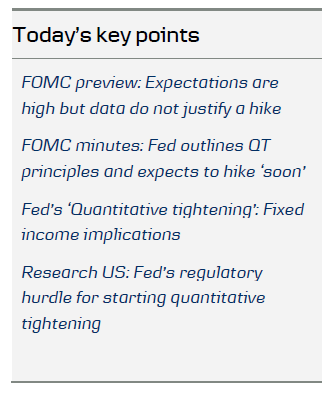
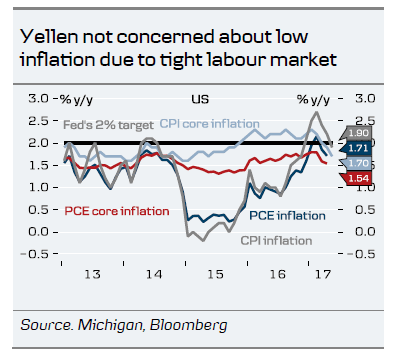
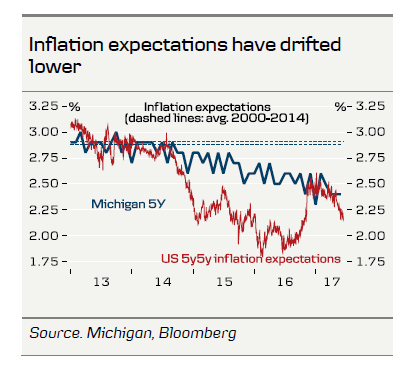
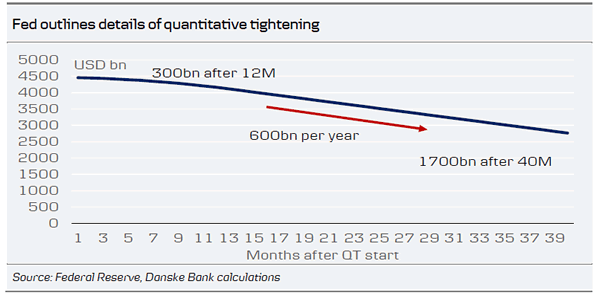
Yellen repeatedly referred to the low unemployment rate and strong labour market data in general, which should be sufficient to push wage growth and inflation higher eventually, in her view. At least the Fed’s inflation target seems more like a ceiling than a symmetric target. Also note that Fed removed that it closely monitors ‘global economic and financial developments’. Overall, markets interpreted Yellen’s comments at the press conference quite hawkishly, as the USD strengthened and US yields moved higher.
We think we learned two very important things. Firstly, the Fed is not as data dependent as it claims to be. Secondly, the Fed more or less only targets the labour market. As we wrote in FOMC Preview: Expectations are high but economic data do not justify a hike, we fear the Fed is making a policy mistake here, as economic data do not justify a rate hike, in our view. Our base case was that a data-dependent Fed would wait at least one meeting to get more data points to support that the weakness in economic data is temporary, especially as it could afford to stay patient, as underlying inflation pressure is not high. This is also what the market tells us since market-based inflation expectations have dropped since the surprising hike in March and the market thinks it is less than 50/50 whether the Fed hikes again this year. However, we stick to our view that the Fed would at some point be forced to do the right thing.
Turning to the updated projections, the ‘dots’ signal was unchanged at one more hike this year, three hikes next year and a neutral Fed funds rate at 3%. However, it is quite interesting to look at the individual dots, as four FOMC members expect no further hikes this year. One is obviously Bullard (non-voter), who has been an outlier for a long time. The other is Kashkari who dissented yesterday. The question is whether the last two are voting FOMC members or not. We guess it is Evans and Brainard (both voting FOMC members), who have expressed concerns about the recent weakness in inflation rates. If we are right, three of the nine voting FOMC members are quite dovish, which also puts a third Fed hike this year into question.
Based on yesterday’s meeting we agree with markets that it is not a given that the Fed hikes again this year but given the Fed’s desire to start quantitative tightening we will likely get more details in September so it can start actual QT in Q4 this year (see more below). Right now we are tilted towards a third hike this year in December, as Yellen targets the unemployment rate, but since monetary policy works with a lag and real rates have risen close to neutral (approximately 0% according to the Laubach-Williams estimate) due to lower inflation expectations, the Fed may not hike again this year. At least we think risks are skewed towards the Fed pausing its hiking cycle next year, so we expect a maximum of 1-2 hikes next year if anything.
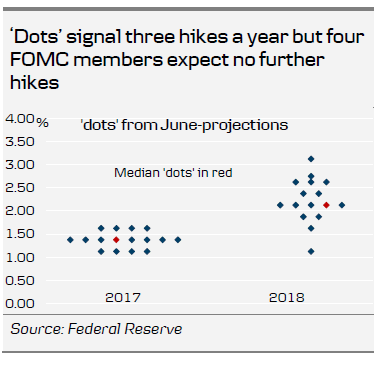
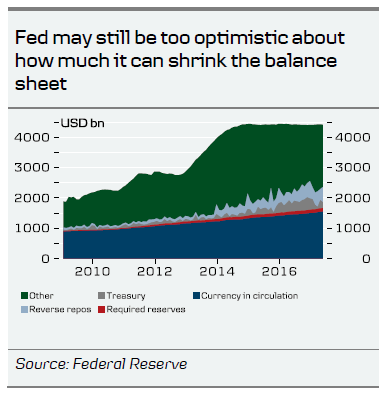
Fed may be too hawkish on quantitative tightening
We are also surprised that we got a combination of a rate hike and a lot more details on the Fed’s plan to shrink its balance sheet (‘quantitative tightening’, QT), see also FOMC issues addendum to Policy Normalisation Principles and Plans. That said, we are still missing the two most important details: the actual triggers (which most FOMC members want to attach to a quantitative threshold based on the FOMC minutes from the March meeting, see FOMC minutes: Quantitative tightening moving closer, 5 April) and the target for the future appropriate size of the balance sheet. However, the Fed seems very committed to start QT this year and Yellen said at the press conference that it could begin ‘relatively soon’, i.e. already in September, so it is not unlikely the Fed has skipped the idea of announcing a quantitative threshold for starting QT.
The Fed plans to:
- Initially cease reinvesting for USD6bn in Treasuries, which will increase in steps of USD6bn every quarter over a year until it reaches USD30bn per month.
- Initially cease reinvesting for USD4bn in mortgage-backed securities, which will increase in steps of USD4bn every quarter over a year until it reaches USD20bn.
In total, the Fed will cease reinvesting in bonds for an amount of USD300bn the first year (60% Treasuries and 40% mortgage-backed securities) and USD600bn per year the following years until the target is reached.
In Research US – Fed’s regulatory hurdle for starting quantitative tightening we highlighted an optimistic scenario for reducing the balance sheet to be one that targets a total reduction of around USD1,700bn over five years that would amount to an average monthly reduction of USD30bn. With the details provided, the Fed may be too optimistic about QT, as it will amount to USD50bn per month after the first year. However, we still do not know what target for the level of the balance sheet it aims at.
However, in our view, a good thing is that the Fed recognises that the size of the balance sheet must be higher now than pre-crisis since demand for central bank reserves has increased due to increasing financial regulation. In 2015, most of the largest US banks held 20-50% of their HQLA in cash and central bank reserves. Furthermore, European and Asian banks are also required to monitor their liquidity reserve in USD. Large Nordic banks are required to hold HQLA in USD. That said, it remains a question whether the Fed is still too optimistic about how much it can reduce the balance sheet
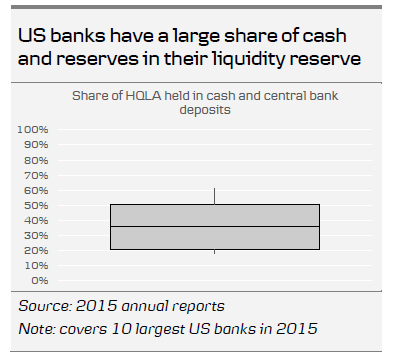
EUR/USD still set to move higher in 12M
Following the FOMC announcement EUR/USD essentially saw the gains towards 1.13 caused by the weak US CPI figures in the afternoon being wiped and the cross is now back to slightly above the 1.1210 level. Markets clearly interpreted Fed chair Yellen hawkishly during the press conference since she emphasised the strength of the labour market and downplayed lower actual inflation and inflation expectations. However, the drop in actual core inflation in May combined with lower inflation expectations make the FX market – rightly in our view – doubt that the Fed will in the end be able to move on with the somewhat aggressive tightening scheme that yesterday’s message otherwise hints at. In that sense, yesterday’s move from the Fed is not too different from that of the ECB last week in illustrating the eagerness of central banks to move away from very accommodative and non-conventional measures, but the inflation outlook does not yet justify them taking such moves much further any time soon. Thus, USD strength driven by Fed should prove temporary in our view.
We are tactically short EUR/USD in the Danske FX Trading Portfolio for a dip below 1.10 in the cross over the summer driven by a Fed determined to move on with policy normalisation and an ECB that could be side-lined for a while as inflation and eurozone growth lose momentum. That said, we see a clear risk of the Fed moving too much, too fast on hikes and/or QT near term and thus will be forced to pause later on – and possibly at a time when the ECB is ready to take the next step away from further easing towards yearend. Crucially, this could in our view be the catalyst for unlocking the EUR/USD upside potential (our models point to the mid 1.20s as ‘fair’ longer term) that fundamentals have been pointing to for an extended period of time
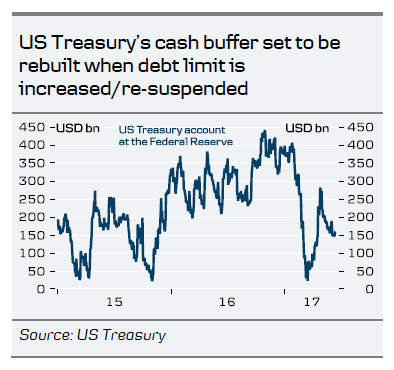
Perfect storm may hit USD liquidity in H2 17
We see a risk that a perfect storm may hit USD liquidity in H2 17. Besides Fed rate hikes and quantitative tightening the US Treasury will likely soon begin to drain liquidity from the market, when a solution to the debt limit issue is found. US Treasury exhausts its ‘extraordinary measure’ possibly early autumn so Congress must either lift or suspend the debt limit soon to avoid a US government default. As we expect a deal to be reached eventually (although most likely not until very close to the deadline whenever it precisely is), the US Treasury will likely begin to rebuild its cash buffer (which US Treasury aims at USD150-450bn) in late Q3 or in the beginning of Q4 this year, thus draining dollars from the system.
As the Fed may be too optimistic about its ability to shrink its balance sheets, we see a risk of the start of an unwarranted tightening of USD liquidity over the coming 3-12M depending on the timing of the start of the reduction. That should widen the EUR/USD XCCY basis and be a negative contributing factor for EUR/USD, especially now that 40% of the reduction is conducted by ceasing reinvesting mortgage backed securities
